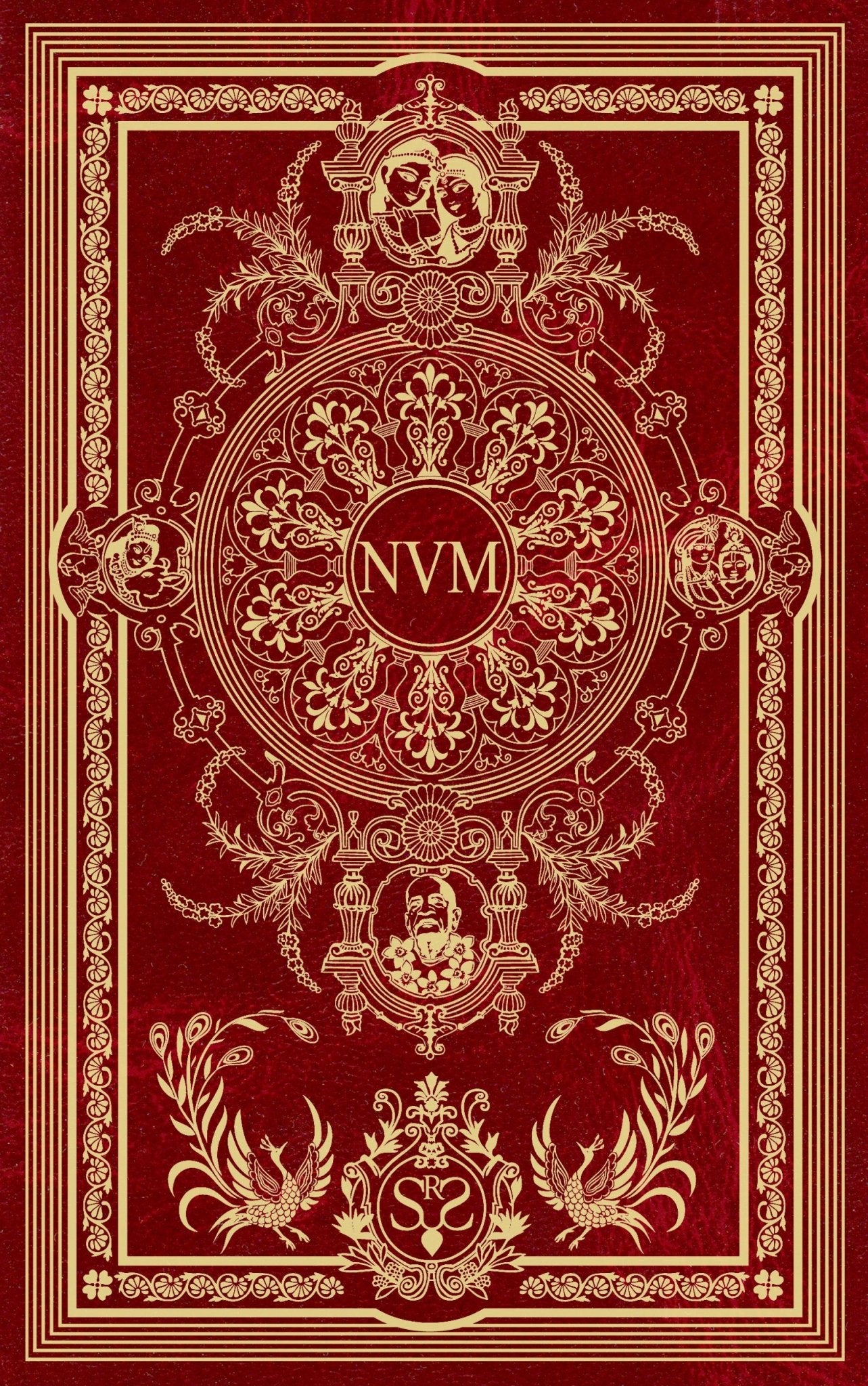
Conceived as a guide to Vṛndāvana-parikramā in Hungary, Nava-vraja-mahimā grew into a monumental dhāma-māhātmya: eight text volumes plus a dedicated atlas of maps. In three-line prose stanzas, Śivarāma Swami narrates Kṛṣṇa’s līlās at the major and lesser-known tīrthas, interspersed with appendices that clarify dhāma-tattva, history, and practice. The work stands in the line of Rūpa Gosvāmī’s Mathurā-māhātmya and Bhaktivinoda Ṭhākura’s Navadvīpa-dhāma-māhātmya, yet is distinctly contemporary in scope and vision.
While conceived for the Hungarian New Vraja-dhāma, the text affirms that the dhāma there is non-different from eternal Vṛndāvana. Thus, its descriptions, meditations, and parikramā routes are not confined to a single geography but open a doorway into the transcendental realm itself. For devotees visiting India, Nava-vraja-mahimā becomes a living companion on their own Vṛndāvana-parikramā, guiding the heart through the same forests, rivers, and līlās it evokes in Hungary’s sacred hills and meadows.
The heart of the series is parikramā—moving from forest to forest, hill to riverbank—so the reader “walks” through Vraja while absorbing the corresponding līlās. Each chapter includes maps and artwork; extensive appendices anchor the narrative: from a history of Bhauma Vṛndāvana and surveys of pastime places, to responses to modern criticism of Vraja’s markers, and meditations like “Uddhava Reads Kṛṣṇa’s Letters to the Gopīs.” The closing ten chapters are a sustained contemplation on mantras, offering deep meditations on the Gauḍīya dīkṣā-mantras and the Hare Kṛṣṇa mahā-mantra.
More than a record of sacred places, the series witnesses Śrīla Prabhupāda’s vision that Vṛndāvana manifests wherever Kṛṣṇa is worshipped with love. By uniting rigorous śāstric research with the active service of Rādhā–Śyāmasundara in New Vraja-dhāma, it invites both seasoned pilgrims and first-time readers to enter Vṛndāvana—whether walking its Indian forests or its Hungarian fields—and to discover it within their own hearts.
Volume by Volume Summary
Volume One — The Truth of the Dhāma – Mathurā, Nandagrāma, and Their Surroundings
Nava-vraja-mahimā — Volume One
Volume One establishes the lens and the route. After a preface, auspicious invocation, and a substantial introduction, “The Truths of the Dhāma” sets out how and why Vṛndāvana manifests wherever Kṛṣṇa is worshipped, and how New Vraja-dhāma participates in that reality. This equips the reader to relish the parikramā that follows.
The parikramā proper opens with “The Beauty and Wonder of New Vraja-dhāma,” then moves to “Pastimes in Mathurā,” “Madhuvana, Tālavana, and Kumudavana,” and “Nandagrāma.” Along the way, the narrative alternates between richly sourced līlā-kathā, local topography, and personal reflections and prayers, all arranged in the series’ signature three-line prose stanzas, with maps to guide the reader’s mental pilgrimage.
Six appendices round out the volume—morning prayers, a concise history of Bhauma Vṛndāvana, a directory of pastime places, a brief on Vṛndāvana’s supremacy among holy sites, a reasoned reply to modern doubts about Vraja’s stone markings, and a poignant meditation in “Uddhava Reads Kṛṣṇa’s Letters to the Gopīs.” Together they make Volume One both a doorway for newcomers and a sturdy companion for experienced pilgrims.
Volume Two — The Sacred Places of Kāmyavana, Yāvaṭā, and Varṣāṇā with Their Surroundings
Nava-vraja-mahimā — Volume Two
The second leg of the parikramā traverses the western sweep of Vraja: Kāmyavana; Śeṣa-kadamba, Yāvaṭa, Saṅketa, and Bahulāvana; then Varṣāṇā and Umrao.
Expect forest portraits and village scenes—Vraja-vāsī life, landmarks, and pastimes—culminating in the Umrao sequence: Rādhā’s abhiṣeka and coronation, Her adornment and procession. Volume Two shifts the mood from orientation to immersion: the geography of Vraja becomes a living stage on which Rādhā and Kṛṣṇa’s love plays out.
Volume Three — The Glories of Govardhana – Pastimes and Parikrama
Nava-vraja-mahimā — Volume Three
Volume Three is a Govardhana-rich arc: the Annakūṭa festival, Kṛṣṇa lifting the mountain, the Vraja-vāsīs living beneath its shelter, and a pilgrimage that threads Nārada-vana, Harideva, and the sacred cluster around Brahmā-kuṇḍa and Mānasā-gaṅgā.
Toll pastimes and boat līlās, Surabhi’s worship and Airāvata-kuṇḍa, Rudra-kuṇḍa and Mān Garh—jealous anger, pacification, swing pastimes, and rāsa. The appendices widen the lens, from apparent transience in an eternal realm to classic meditations like Tava Kathāmṛta.
By weaving theology into the terrain of Govardhana, the volume grounds ecstatic narration in Gauḍīya siddhānta: shelter is not metaphorical, it’s a place you can walk, remember, and serve.
Volume Four — The Glories of Rādhā-kuṇḍa and a Commentary on Vilāpa-kusumāñjali
Nava-vraja-mahimā — Volume Four
Centred on the Yoga-pīṭha and Rādhā-kuṇḍa, Volume Four guides readers through the intimate Vṛndāvana of the Gosvāmīs: Śiva-khor to Svānanda-sukhada-kuñja, then onward to Rādhā-Gokulānanda Mandir.
The appendices are a treasure: a reader-friendly presentation of Vilāpa-kusumāñjali, practical guidance on worshipping Lord Balarāma, and a survey of how the Vedas reveal Śrī Rādhā. Together they transform parikramā impressions into daily sādhana and sublime meditation.
Volume Five — The Areas of Ādi-badrī, Vṛndāvana Town, and Other Holy Places
Nava-vraja-mahimā — Volume Five
Volume Five continues the Vṛndāvana circuit through iconic sites—Ādi-badri and Yāṭeśvara, Sevā-kuñja and Rāmaṇa-reti, Rāṇavārī to Sūrya-kuṇḍa, Jhalanavana to Gopakūṭa—before turning to lesser-visited corners of the dhāma.
Vivid sketches of līlā-sthānas alternate with historical and practical notes. Two appendices address perennial questions devotees ask on parikramā: the ages of Kṛṣṇa and the Vraja-vāsīs, and the worship of Vaiṣṇava samādhis.
Volume Six — The Holy Places Along the Yamunā
Nava-vraja-mahimā — Volume Six
Opening with Ajani to Bhāṇḍīravaṭa, then Gopī-ghāṭa to Sanorakhā, Varāha-ghāṭa to Keśī-ghāṭa, and Dhīra-samīra to Bhatrolā, this volume follows the Yamunā’s devotional shoreline. It then extends to Kurukṣetra, Śukratāl, and Naimiṣāraṇya, and swings back through Śyāma Mandir to Rāmaṇa-reti and Yamalārjuna-tīrtha to Rāval.
Alongside the parikramā are practical appendices: discussions on Vraja’s yearly festivals, insights into svakīyā–parakīyā, a guide to Janmāṣṭamī observance, and notes on practitioners who become gopīs in Kṛṣṇa-līlā.
Volume Seven — The Glories of the Gāyatrī-mantra
Nava-vraja-mahimā — Volume Seven
An entire volume devoted to the Gauḍīya dīkṣā mantras, taking you from Brahmā-gāyatrī through to Kāma-gāyatrī. Each chapter opens the mantra’s meaning and mood, drawing on related pastimes and meditations so chanting becomes richer, more absorbing, and deep.
Śivarāma Swami guides us on where to place the mind and heart while chanting: how Brahmā-gāyatrī blossoms within the Bhāgavatam’s first verse, why the Garuḍa-purāṇa calls the Bhāgavatam the gāyatrī’s own commentary; how Guru-gāyatrī fixes one’s gaze on śrī-guru; and how Gopāla- and Kāma-gāyatrī refine attention toward Rādhā–Śyāmasundara’s direct service.
The volume’s real aim is to bring out the meditation and mood for each of the mantras more than regulations and technique of chanting.
Volume Eight — The Glories of the māha-mantra
Nava-vraja-mahimā — Volume Eight
A whole volume on the Hare Kṛṣṇa mahā-mantra—its glory, practice, and inner meaning. The book opens with an Introduction to the Mahā-mantra, followed by a guide on the offences to avoid, and then offers four chapters of meditation on the mantra’s names and relationships—so chanting becomes informed, absorbing, and deep.
It answers the questions every chanter asks: why this mantra and where it appears in śāstra; whether to chant in japa or kīrtana; how to place the mind and heart while chanting and how to recognise and uproot aparādha. This volume is a unique exposition of the mahā-mantra’s meaning, paired with meditations and the Vraja-līlās they point toward. It helps us move from the realm of practice to taste, absorption, and ultimately love.
Volume Nine — The Maps of New Vraja-dhāma
Nava-vraja-mahimā — Maps & Atlas (Volume Nine)
The ninth volume is a map book for Vraja dhāma, created to accompany the text set with precise routes and succinct descriptions of each tīrtha.
Clear, chapter-matched maps for all parikramā segments—useful for on-site pilgrims and armchair travellers alike. The short notes condense līlā associations without overwhelming first-time readers.
The atlas turns devotion into direction. It helps you plan, pace, and pray your way through Vraja, keeping the narrative and the terrain lovingly aligned.
Hardbound
Gilt-edged
140x212mm / 5.5x8.3in
Vol 1. – 720 pages
Vol 2. – 576 pages
Vol 3. – 776 pages
Vol 4. – 768 pages
Vol 5. – 688 pages
Vol 6. – 976 pages
Vol 7. – 584 pages
Vol 8. – 808 pages
Map book – 272 pages – 212x280mm / 8.3x11in
Sample Chapter from Volume 1:



